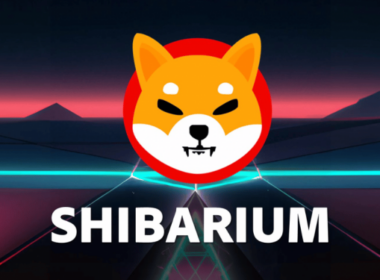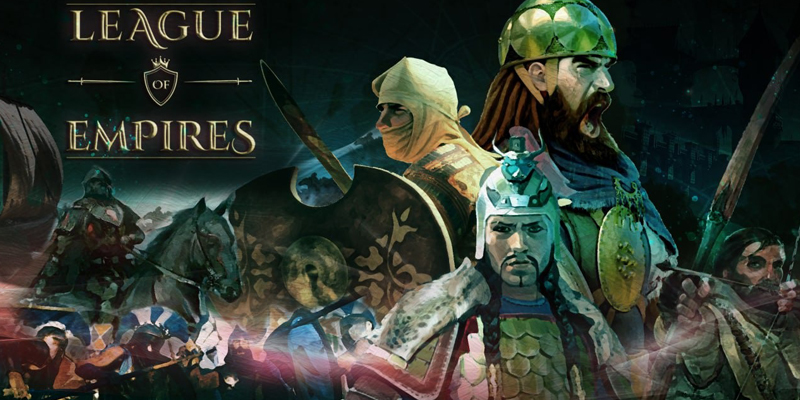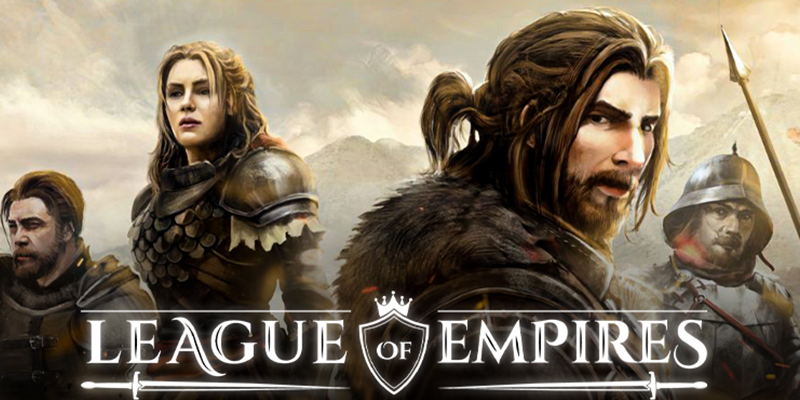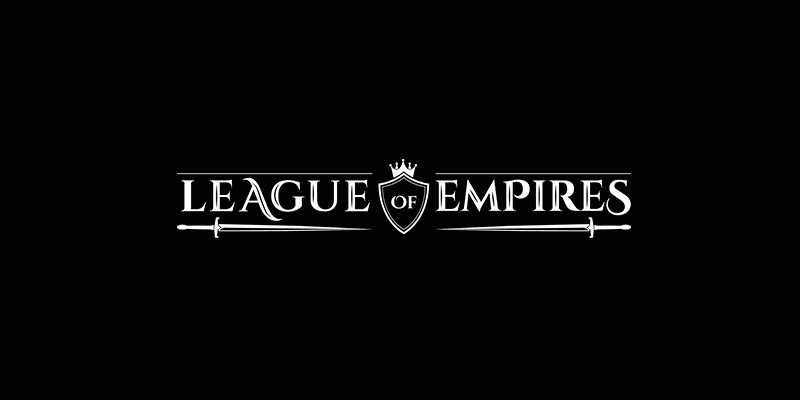League of Empires is a massively multiplayer real-time strategy war game where players can enjoy earning cryptocurrencies in a stimulating and adrenaline-fueled environment.
In this article, we will discuss:
League of Empires: Game view
league of empires is the first true blockchain MMORTS game. It offers rich and immersive gameplay. Train and command your troops in stunning 3D wars! Form alliances, fortify your land, deploy different strategies and increase your defenses to protect your treasures from enemies. Gather resources and train your army to increase its power and expand it into a mighty Empire.
Experience the best of games blockchain! Challenge the world in multiplayer PvP style with a custom army of your favorite units. Think and play like a general. Build artillery and use it tactically on the battlefields or sell it on the market. Fight for different achievements, enjoy adrenaline-pumping gameplay and earn LOE tokens along the way!
Main Features
- Buy, sell and rent land – Each player will need a land to start playing. Have an excess of land? Sell or rent it on Marketplace.
- Build and sell artillery – There are 10 different types of artillery. Build your own, use them on battlegrounds, or sell them on the Marketplace.
- form alliances United we stand, divided we fall. Forge powerful alliances with global players and grow faster!
- PvP and PvE modes – Test and train your skills in PvE modes. When you're ready, switch to PvP modes and leagues and earn even better rewards!
Build the Final Kingdom
- Console Quality Graphics – Plan, strategize and fight enemies in a stunning 3D fantasy world.
- Dominate with Strategy – Train your troops, equip them with powerful artillery and lead them into epic PvP battles.
- Real-time Battle Control – Go to war with thousands of troops, all under your direct control.
- Non-stop Campaigns and Events – Daily Quests, Leaderboard Challenges, Exclusive Campaigns and Alliance Events.
NFT Marketplace
- Sell and Rent Land – Turn every 11 land captured into an NFT. Use it in the game, sell it or rent it out to other players to earn passive income!
- Tactically Deploy Artillery – Increase the strength of your war by using artillery on the battlefields tactically.
- Perfect NFTs – Create your own artillery, terrains, leagues, war academies and artillery factories depending on the behavior of the qualified game.
- Play in Leagues – Earn more rewards and play in leagues alongside players from around the world!
- Alliances and Leagues – Chat and team up with friends to strategize in real-time MMO and dominate other empires. Play in leagues and earn even bigger rewards!
- Strategies and Construction – Deploy your own strategies and policies! Build and customize your own Empire. Collect resources, create NFTs, loot various rewards, train your troops to conquer and grow your empire of the metaverse!
Turn your passion for games into income
Players spend billions each year on in-game items they don't actually own. We believe there is a better way. Players deserve to be able to own and exchange their in-game assets for real money. League of Empires is a play-to-win game where players can turn their passion into real income.
In addition to the earning potential for players, we place a lot of emphasis on game quality and time spent. After all, gamers are the ones who run the ecosystem and deserve better gaming experiences that most play-to-win games lack. We are on a mission to change that and redefine the meanings of a blockchain game.
- High Entertainment Value – League of Empires offers console-quality 3D graphics, immersive game mechanics, and a real-time world-building and battle system.
- Play to Win – Engage in the most awe-inspiring wars, whether playing solo or with alliances or leagues, and win real cypto and NFTs.
- Create and sell NFTs – Mint various types of NFTs like, Artillery, Factories and Land. Use them in your game or sell them on Marketplace.
- PvP Battle Modes and Leagues – Fight in PvP modes to secure top positions and climb the leaderboards for greater rewards and earnings.
- Real-time strategy and control – Design your unique formation, implement a real-time strategy, take full control of your troops and guide them to victory.
- Form alliances with real players – Chat with global players, make friends and form great alliances with players and win great prizes together.
Integrated NFTs
- Buy, sell and rent land at a profit
- Buy land, upgrade it, expand it into an empire and sell or rent it on the market.
- War Academies
- Gather enough resources and create your own War Academies. Use them in your game or sell them on the market.
- Artillery Workshops
- Mint new artillery. Use them in your game or sell them on the market.
- own leagues
- Own leagues on the blockchain. Earn a guaranteed share of player earnings.
Heart and Soul of League of Empires
If you reduce the project to its basic core, we are left with a 'game'. It all boils down to a competitive activity, with a set of rules where players engage in a challenge that provides entertainment and fun. Players will also be rewarded for successfully overcoming the challenges set to them.
Competition can take place at two basic levels: Player versus Player and Player versus Computer. The Player versus Player aspect will make it very important for the game to have a set of identities (civilizations) that are balanced and unique. This is useful for providing a sustainable multiplayer experience. Player vs. Computer will require a deep and strategic understanding of the game to be able to play with different difficulty levels for the AI that simulates the actions and reactions of a human player. This is useful for providing a fun and engaging single player experience.
The game rules are intended to give players a wide variety of choices to make. The more choices we allow, the more depth of strategy the game can offer. It's important that the range of choices is wide enough to allow the player to choose from a range of actions – each with a unique set of repercussions. And LoE offers a wide variety of options and strategies for deployment. Some of them even more than many RTS games in the traditional gaming industry.
Combat will be the focus of the competition. Economic and diplomatic actions will be used to forward militaristic actions. Each entity in the game will have a specific purpose and use. Just like in the game of chess, each piece on the board has a specific role in a game. Also as in chess, a player who 'thinks ahead' and can 'set up' an opponent will benefit from such actions. This interactive/real-time contest should challenge the mind and avoid repetitive and boring actions. Therefore, players will see the following actions as fun:
- A triumphant assault
- Successfully repelling an attack
- Creating your base
- Setting up your economy
- Tricking an opponent using the correct technology
- Advancing your civilization
- A victory from behind
- Proper use of formation in a battle
- effective invasion
- acquiring territory
- recreation of civilizations
- reversing the result
- Advancing a unit to a higher rank level
- Creating scenarios for others to play
- Forming alliance with another human player against a common enemy
- Diplomacy
- Trade and Commerce
When a player is given an obstacle to overcome and he reaches his goal, he will be rewarded. It will be the reward that will encourage them to keep playing. The more they play, the more parts of the game they 'unlock'.
Traps
It is very easy for a game to fall victim to many of the common mistakes that are disastrous for RTS genre games. We make sure to keep our guard up and avoid these pitfalls:
Fastest click wins – In many RTS games, it's not the player with the most intelligence or the best strategy that wins, it's the player who a. knows the correct order of actions and b. run them faster. People who practice a general procedure that is usually rewarding and who are familiar with keyboard shortcuts should have a bit of an advantage, and they will still be needed; but, if the opponent recognizes your 'cookie cutter' gameplay, he should be easily able to outsmart them by identifying and counter-attacking tactics with an effective counter-attack strategy.
Unique path to victory – It seems to be a trend that games cater to a specific strategy that is often used to achieve victory. This can be running, turtling, growing, etc. We recognize all of these methods as valid ways to win a game, and the game does not try to favor one over the other. Players must be and will be able to successfully use (and adapt/change) any strategy to achieve victory. This is a real-time strategy game and players can deploy any strategy they prefer to win the game.
Sneaky tricks – Many games ignore some aspects of gameplay that are unintentionally (by game designers) used to a player's advantage. Through many hours of gameplay testing, we have identified and eliminated these tricks.
frustration of Artificial Intelligence – It is important to minimize frustration when playing the game. The game is rigorously tested and we have kept ease of use and mastery of the game as key elements of the game so that player frustration can be avoided.
Confusing user interface – It's very important to avoid spoiling the gameplay by making the UI so complicated that people aren't able to do what they want to do and stop playing because they can't figure out how to control it. We are working on an interface that can be easily captured by our target audience. It is essential to pay special attention to other games of our genre that we will attract players from. On top of that, we've also added keyboard shortcuts so players have to deal with as little clicks as possible.
Repetition – If you find yourself doing the same action over and over without thinking, then we need to eliminate or automate that action. Repetitive linear procedures are meaningless and boring. So the AI is programmed in such a way that some of the repetitive tasks like a citizen collecting wood can be automated during the game.
overly ambitious – Even though we've been in the gaming industry for almost a decade, I think it's very important to always remember that this is the first blockchain project we've ever done. Much of the knowledge we acquire is based on trial and error. We will probably continue to move forward in this way. We need to understand our limits and avoid fixating on them. Therefore, our goal is to keep schedules as realistic as possible.
Too Much Rating and BMI: Projects these days are highly valued and they spend a lot of money on the hype for TGE without a real project in the background. In LoE, it's the opposite. The main focus is on the game and almost all of the game's development work was done on an internal budget. The project started in September 2021 and in April 2022 alone, we raised around $100k for the private round. The total project valuation is held at $9.000.000 ($9 million), leaving plenty of room for the token price to grow.
Why LoE?
What do I gain from this? Why would anyone play our game instead of another game? I think the biggest factor in answering that question would be that the game is FREE and it's a real game to play rather than click to win games like that. LoE is also the first real-time strategy game on the blockchain. The game also offers NFTs that players can own, mint, evolve, upgrade and sell on the market for profit. Other than that, the game offers stunning graphics, an immersive storyline, real gameplay and leaves gamers with a gaming thirst that could not be quenched. We've also included some features that set us apart from the crowd and make the game unique:
Story Element – Allows people of the modern world to relive moments and engage in wars and tactics like our ancestors did.
Citizen Soldiers – There will be no default villager unit. Instead, regular infantry and cavalry have not only military but also economic capabilities, making them substantially more versatile than typical RTS games.
Automatic Unit Update – Citizen Soldiers will gain experience and automatically earn promotions. With each rank, they become stronger and gain a different appearance.
Units in Structures – Some garrisoned units will be visible on the battlements of structures or on the decks of ships, and will be able to fire at opponents from a distance.
realistic ships – Ship gameplay will include a variety of new features, from a much larger scale, ship capture, sea rams, to a modular design that allows catapults to be positioned on decks and units to fire from the bow.
More multiplayer modes – The host will have a wide variety of game types and features to adjust when creating a game session, allowing for the type of gameplay they like best.
Provinces and Territories – In some game types, the map is subdivided into Provinces that must be captured and attached to a player's territory to harvest their valuable resources and build forward bases in those areas. If the host wishes, a player's Home Territory can also be surrounded by friction edges to reduce early runs.
Realism of the real world map – random maps based on geographic regions where ancient world civilizations lived and 'died'. They are spawned with location-specific biome features that replicate (as we have best researched) the appearance of the world as it has existed throughout known history. This provides greater immersion of the player in the game.
LoE gameplay basics
Gameplay in a nutshell
In a nutshell, in LoE, you start with three things:
buildings, such as urban centers, Units, such as male citizens and soldiers, which you can move around the map and use to gather resources, build or fight, and some starting amounts of four means: Food, Wood, Stone and Metal.
In LoE, you need to gather more of these four resources and use them to train (create) various units in your buildings. In turn, you'll need to put some of the new units to work collecting more resources and building more types of buildings. That way, you build a strong economy with a steady stream of income from all four resources and get ready to build a strong army.
As soon as possible, you need to train a large and powerful army, which may even include siege weapons and warships. Training each of these military units costs the resources you've collected. Ultimately, you will send your army into battle in an attempt to destroy all your enemies' structures that can spawn units and all units that can build buildings. The first player to reach this goal wins.
gathering resources
The sum of all resources on the map is limited. These resources can be gathered in several ways:
- Food: Foraging in bushes and certain trees; Hunting certain wild animals or slaughtering livestock such as chickens and sheep; Fishing; Agriculture.
- Wood: Cut down trees.
- Stone: Mining of stone mines.
- Metal: Mining of metal mines. (They occasionally glow, to make them easier to distinguish from stone mines.)
(On certain maps, you can also quickly collect a large amount of resources from special treasures found on the map, such as shipwrecks.)
Transfer to drop sites
When units collect a resource, there is a lot they can carry. Then they need to transport the resources they've gathered to a building that serves as their resource drop-off locations and drop them off there. Only then can they return to gather more resources. Town centers and docks serve as launch sites for all four resources. The mills only serve as drop sites for wood, stone and metal. Farms serve as food delivery locations.
Units automatically transport the resources they are gathering to the closest drop location that can accept them. It might be a good idea to build launch sites close to their corresponding resources, to ensure that your collection units only need to transport short distances, which saves time and makes collection more efficient.
training units
Most buildings in LoE can train (create) units. If you select a building, you can see in the lower right panel what types of units can be trained in that building and how much each type costs.
- Population – Each new unit counts towards your population limit, indicated in the upper left corner of the screen. The limit can be increased by building more buildings such as houses.
- Rally Points – If you select a building and right-click on a point on the ground, you will create a rendezvous point, which is a destination that each new unit created from that building will automatically go to. Rally points can be defined on resources, so that units automatically collect this type of resource when they are created.
working with units
Units in LoE can be placed on a continuum from "civilians only", who are used almost exclusively to accumulate resources, to "military only", who can only fight. In between, the game features a wide variety of citizen soldiers, who can do a little of both.
- female citizens – You usually start a game with a few female citizens, who are the driving force of your economy. They specialize in gathering resources, mainly food, gathering food and farming more efficiently than other units. They can also build civic buildings, such as resource drop-off locations, and make nearby male units work faster. While they can attack enemy units, they are very vulnerable to virtually any other unit.
- citizen soldiers – Some units have the dual role of workers and soldiers, which means they are citizen soldiers. For example, hoplites can not only fight, but also cut wood. Citizen Soldiers have bonuses for collecting wood, stone and metal. Certain buildings, such as fortresses, can only be built by citizen soldiers.
- Classifications – The more citizen soldiers fight, the more battle experience they gain and automatically rise through the ranks. With each level, they become stronger and look different, but they also gradually get worse at “civilian” tasks, such as gathering resources.
- Champions and Heroes – You can also train champion units, which are more expensive than citizen soldiers and cannot do any tasks other than fighting, but are stronger and better at fighting. You can also train exactly one hero in a game, which is a very strong single unit.
exploring the map
- Cloak of Darkness – You start with only a small part of the map revealed to you; The rest is covered in black. This black cape is called the Shroud of Darkness and it could be hiding your enemies base, useful resources, and more. The shroud is gradually removed and the map is gradually revealed as you send units to explore new parts of the map.
- fog of war – Areas that you have explored but currently have no units or buildings appear with a gray shading covering them. This is the Fog of War. Even if things change on the map, under the Fog of War you will only see objects as they were when your units or buildings last “seen” them. For example, if trees are cut down or a new enemy building is built under the Fog of War, you will not see the change unless you send a unit there again. Importantly, enemy units are not seen under the Fog of War.
If you have allies, you can see the parts of the map that your allies have explored and vice versa.
gathering intelligence
When exploring the map, you should try to find:
- treasures,
- Resources,
- Strategic areas on the map, such as river crossings,
- The location of your enemies' bases,
- How fortified are the bases of your enemies,
- What kind of military units have they trained, and more.
All of this information can help you make the decisions that will make you victorious, such as the best direction to expand your base and the types of units you should train to fight your opponent.
Dynamic Territories
Most buildings can only be built within their own territory, marked by colored borders on the ground. Players can expand their territory by building buildings near their borders. (Some types of buildings will expand their territory more than others.) Boundaries can change over the course of the game, based on buildings constructed and destroyed by players.
If one of a player's buildings falls into enemy territory due to changing borders, the building will slowly lose allegiance until it finally converts to the enemy's side. This can be stopped and slowly reversed if the ledge changes and the building moves back to the player's side.
Important exceptions: There are a few important exceptions to this rule:
- Outposts, docks, and entrenched army camps can be built outside your borders, but none of them will give you new territory;
- The Town Center can be built on your territory or on unclaimed territory, but it must be built some distance from your existing town centers. Building a town center can gain you a lot of extra territory. Also, as you progress through the different stages of the game (see “Technologies and stages of the game”), the territory controlled by your urban centers will also expand a bit.
- Docks do not lose loyalty/health outside their territory, but entrenched army outposts and camps do. Entrenched Army Camps can also be built in enemy territory.
Technologies and phases
Technologies, or techs, are economic or military bonuses that can be “researched” (purchased) for resources in designated buildings. Hover over the technology buttons to learn more about the costs and benefits of each technology. In LoE, some technologies come in mutually exclusive pairs: this means that within each pair you can research one technology or the other, but not both in the same game. These technology pairs are represented on the screen by a link symbol “connecting” two buttons.
Phases LoE describes a city's progression from humble beginnings to greatness in three phases: the Village Phase, the Town Phase, and the City Phase. When the game starts, you are already in the Village Phase. If you want to progress to the Town and City Stages, you need to research each of them in the Town Center. Levels are like technologies, but much more valuable, because reaching a new level unlocks many new types of buildings, units, and technologies. Researching each level is not only expensive, it also requires you to have built certain buildings:
Advancing to the City Phase costs 500 Food, 500 Wood and requires the construction of five buildings of any type, except for breeding sheds and agricultural fields. (Five houses, for example, is enough, as are three houses, a mill, and a farm) Advancing to the City Phase costs 1.000 Stones and 1.000 Metals, and requires the construction of four buildings of any type that become available in the Phase. of the City (except Walls and City Centers).
Combat
Types of Combat Units
With a few exceptions, all combat units belong to one of these types:
- Infantry: Warriors fighting on foot, with swords, bows and arrows, etc.,
- Cavalry: Warriors on horseback,
- Siege weapons such as catapults and other artillery
- Warships such as triremes.
Melee units vs. at a distance – Some of the units mentioned here are melee units, which can only fight when very close to the enemy (eg with a sword); Others are ranged units, which shoot or throw a weapon from afar, so they only need to get close enough to be within range (but not too close). Each of these types has its advantages and disadvantages. For example, some ranged units can be very powerful against certain ranged melee units, but helpless vulnerable to melee attacks at close range.
Types of damage and balance – Damage in LoE comes in three types: hack, piercing, and crush. Units have different armor for each type. Also, unit attacks can be of several types simultaneously, for example, a hoplite deals piercing and slashing damage.
Also, some units have special bonuses against other specific units, for example spearmen defeat melee cavalry but are countered by skirmishers and cavalry archers. Consider that different units have different movement speeds, fire rates, health points, and costs, and you have a complex game with many strategic choices to make when choosing how to spend your resources. The game documentation can be found in the description of each unit by hovering over the button to train it.
trading and exchange
A negociação allows you to earn resources simply by having your traders move between markets or docks. Traders traveling by land can be trained at the markets, and merchant ships sailing at sea can be trained at the docks. (The following explanation refers to markets and docks; “Market” is used for short.)
Establish a trade route between two markets by selecting a trader and right-clicking on two markets one after the other, setting them as “source” and “destination” markets. Your merchants will then start transitioning between them, earning resources for each round trip you make; You can choose which resource will be earned by each trader. The longer it takes to travel between the two markets, the more of this resource you'll get at the end of each round trip. You can have a trading bus between two of your own markets or between your market and an allied market. The latter case yields more resources per trip than the former.
A exchange allows you to buy and sell resources in exchange for other resources in the market. Resources are traded at exchange rates that vary with each transaction. For example, to buy 100 Food, you may initially have to spend 100 points of another resource type (Wood, Stone or Metal). In the next deal, however, food will be more expensive. The fees are global, so if another player buys food, it will also be more expensive for you. After a certain threshold (varies by game level), the exchange rate is gradually reset to the standard rate.
More information about League of Empires:
- Website: https://leagueofempires.io/
- Twitter: https://twitter.com/LeagueofEmpires
- Telegram: https://t.me/leagueofempireschat














